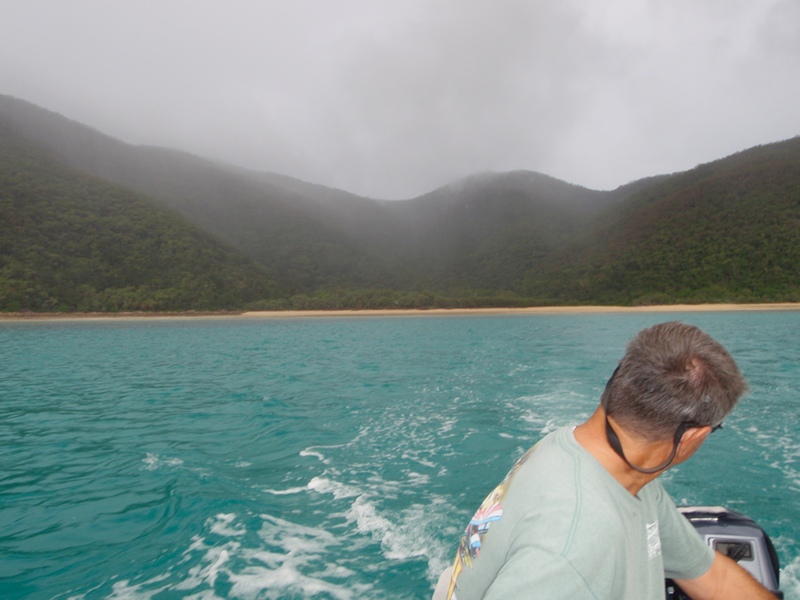Island Hop Stop #1 - Refuge Bay, Scawfell Island, Queensland, Australia

Harmonie
Don and Anne Myers
Fri 21 May 2010 04:51
|
20:51.556S 149:36.067E
The Great Barrier Reef
We've arrived. We've arrived in the waters
protected by the Great Barrier Reef, and we've arrived in the Whitsunday
Islands. First, the reef. The Great Barrier Reef extends nearly
1,000 miles from just south of Mackay to just north of Cape York (the
northeast tip of Australia). It isn't a single structure, but is a
series of coral reefs that spread themselves in a wide line generally following
the Australian coastline, drawing nearer to the mainland as it runs north.
The reef is about 35 miles offshore from Mackay, but only 10-15 miles offshore
from Australia's northeast extremity. For boaters, the Great Barrier
Reef is a plus and a minus. On the positive side, it blocks the swell
rolling in from the Pacific, leaving only wind generated waves
which don't run as big as ocean swell, but tend to be short, choppy and
uneven - more like something you would see on shallow Lake Erie. On
the negative side, the reef, or more accurately, series of individual reefs;
mean extra special care must be taken while navigating through these
waters. There are lots of obstacles and it would be bad form to run into
one. On top of that, the charts are not always 100% accurate, so it's best
to always travel in the daylight and use more than one chart source. That
last bit is not all bad. We don't mind traveling only in daylight,
especially with plenty of islands to break up the trip.
Speaking of islands, the Whitsunday Islands are one
of several island groups that lie between the outer reef and the mainland.
As we make our way north, we will hop through the Whitsundays first. The
Whitsundays and many of the other island groups we'll be cruising
through used to be part of the Australian continent. After the last
ice age, the sea level rose between fifty and a hundred meters when the ice
melted. As a result, the mountain valleys along the northeastern edge of
the Australian continent filled with water leaving only the mountain tops
peeking out. The Whitsundays and many of their cousins are basically
drowned mountains. Good for us
because it's generally much nicer to stop and anchor next to a drowned
mountain than it is to hang out in a murky mud flat infested with
crocodiles on the mainland.
From the time we left Mackay on May 10th to the
present, we island hopped through the Whitsundays. Most of the islands we
visited were of the uninhabited drowned mountain turned national park
variety. No complaints from us - most of the anchorages were not
crowded with only a few other Australian boats seen on occasion, and the
scenery, while not spectacular, has been really pretty as you will
see.
So - Island Hop Stop #1: Refuge Bay, Scawfell
Island
Located within the Great Barrier Reef and only a
measly 25 miles from Mackay, one would think the sail from Mackay to
Scawfell Island would be marvelous. Nope, more like miserable. We
were still dealing with the tail end of that nasty weather system the
vomit-coated sailboat had sailed through two days before. It didn't help
that we were trying to go northeast in a 20-25 knot east wind.
Spoiled downwind sailors like us get testy when we have to sail close to the
wind in a heeled-over fashion, bow-slamming our way through short-choppy Lake
Erie waves. On top of that, we had to tack twice in order to avoid hitting
a couple of drowned mountain islands because we couldn't quite make our
northeasterly course (no one ever said an Amel is a champion upwind
sailboat). And....it was freezing! As most of you head toward
summer, we down here are heading toward winter. Yes, even the tropics
experience some form of winter. On this day, during our cloudy, rainy
upwind sail to Scawfell Island, the temperature in our cabin was sub-80
degrees. Less than 80! We had to break out the jeans and
sweatshirts.
We stayed two nights at Scawfell, one to recover
from our miserable sail and one to wait for Storyteller to catch up (as proper
motorboat people would do, they waited for the wind to decrease before leaving
Mackay).
Picture 1 - Low tide on Refuge Bay beach. The
beach goes on forever when the tide is down twelve feet. Not such a bad
thing unless you happen to anchor at high tide in water less than twelve feet
deep. Then you might be sorry. Nope, we haven't done that yet and
hopefully won't, but if we do, you'd be the first to know because the pictures
would be fun.
Picture 2 - The art of racing the rain in a dinghy
carrying four people powered by an eight horsepower outboard motor. We
won.
Picture 3 - Not only did we win the race with the
rain, but we were rewarded with a rainbow, or at least half a
rainbow.
Anne
|


